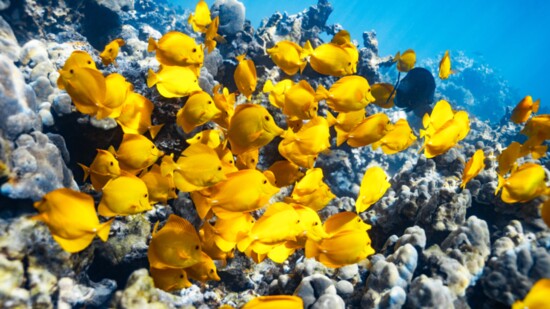Yes, Captain Cook was killed at Kealakekua Bay in February 1779, however, the indigenous people’s history in this wahi pana (sacred place) – their culture, sacred sites. Religious practices and sustainable stewardship of the ʻāina and kai date back more than 1,000 years. And while some note Captain Cook’s arrival here as the first Western contact, oral history, and anthropological studies show that the Dutch visited 300 years earlier in the 1400s, followed by the Spaniards in the 1500s. By the 1700s, several thousand people lived in two villages at Kealakekua Bay and many thousand more in surrounding areas.
Lineal descendants of the ancient Hawaiian villagers have championed for decades to recognize the rich heritage of the area and change the focus from Captain Cook as the stand-out moment in Kealakekua’s history. This goal is accompanied by a commitment to preserve, protect, and enhance the natural resources and heritage sites within Kealakekua Bay State Historical Park (established in 1969) while setting appropriate visitor capacity limits both on the land and in the bay.
Recent leaders of this more comprehensive approach to the initial drafts of a Master Plan for the state park, drafts that began in the 1980s, include Shane Akoni Nelson, Alayna DeBina, Krista Johnson, Rebecca Most and Frank Carpenter who are all members of the Ho‘ala Kealakekua Nui (HKN), a small non-profit that partnered with the State of Hawai’i in 2019 to help with the management of Kealakekua Bay Historical State Park. The group includes individuals who are lineal descendants of the region or are the spouses of those who are.
Frank, the owner of Kona Boys, a long-time local tour company providing water sports rentals and tours of the bay via non-motorized craft such as kayaks and paddle boards, says the group has worked tirelessly to put together a Community Action Plan (CAP) and to create HKN to ensure the community had a strong voice in the Final Master Plan approved in October 2023.
He credits Krista for spearheading community involvement early on by bringing together various interest groups, resulting in the creation of CAP, which was incorporated into the Final Master Plan. Her husband, Charles Kealoha Leslie (aka Uncle Chuck) is a lineal descendant and respected kūpuna (elder) in Kealakekua.
A self-described malihini (newcomer) Frank, who relocated here from California in 2000, says, “All of these board members are united by their love of the place and belief that it is their kuleana (responsibility) to ensure its rich history and natural resources are protected for generations to come. What better investment is there than that?”
Aric Arakaki, superintendent of Ala Kahakai National Historic Trail (which passes through Kealakekua, and is one of many historic trails throughout the country administered by the National Park Service), says the overall goal of the Final Master Plan for Kealakekua Bay State Historic Park is to, “Reveal Hawai’i’s history and preserve significant historic sites and natural resources, and to share Kealakekua within the context of Hawaiian history, perpetuating cultural traditions and values to create a sense of place in Kona.”
Shane, president of the HKN and a lineal descendant living in Napo‘opo‘o who traces his family history in the area back 500 years, says the National Park Service (NPS) partnered with the state in recent years, providing its expertise in trail maintenance.
“The NPS is the very best at it and their work is much appreciated,” he says. “Today, the plan’s top priorities are conducting water quality and capacity studies. Due in part to rising ocean temperatures and human impact, 97% of the bay’s coral is dead, and 78% of the food sources my ancestors and I grew up with no longer exist here – sea urchins, crabs, various fish species and seaweed,” Shane says.
Carrying capacity, Shane says, is another critical concern, “Determining the maximum limit the resource has for human interaction on the bay, the coral, the trails, and heritage sites is a critical first step.”
With funding from both the state and The Nature Conservancy (with the assistance of HKN board member Rebecca Most) a Coral Pilot Program was created with the first coral restoration out planting taking place in late February.
Fellow HKN board member and Kealakekua resident Alayna DeBina, who is the spark behind creating and executing Hana Lima volunteer days, says, “Now that the Final Master Plan is approved, the hard work is ahead of us.”
Hana Lima (working with hands) days take place once a month led by lineal descendants and area residents. The work varies from month to month, she says, and includes trail, shoreline, heiau and pier maintenance, coral out planting and more. The volunteer days also include an opportunity to view the challenges involved through a local lens.
“People forget this is our home, we live here, it’s not just a recreation area. We plan to limit capacity by determining a maximum number of visitors allowed in our village on any given day, and to educate people on proper etiquette when visiting this sacred place,” she says.
In addition to volunteer opportunities, Alayna says monetary donations are always welcome and may be made on the Kealakekua.org website. The site includes a calendar noting monthly Hana Lima days and much more general information.
All of these board members are united by their love
People forget this is our home, we live here, it’s not just a recreation area







